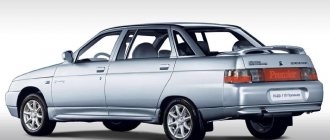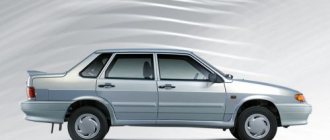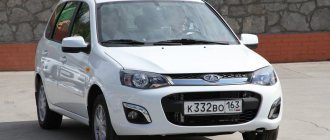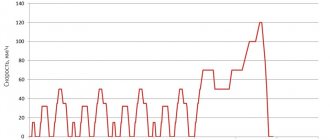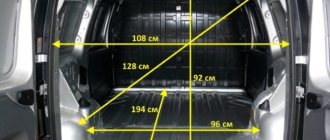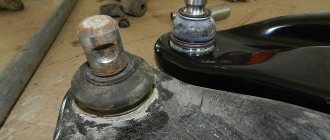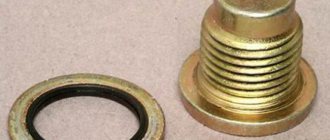Lada Largus cars are a new line of commercial vehicles produced by AvtoVAZ. They first rolled off the assembly line in 2011, and full-scale production began in 2012. The design was developed jointly with the foreign machine manufacturer Renault. The car turned out to be roomy, powerful and inexpensive, which very quickly made it popular among its compatriots.
Gasoline consumption of Lada Largus according to the passport
The passport values for gasoline consumption of the Lada Largus are determined after assembly, in factory testing laboratories. At the same time, such measurements are for informational purposes only, since the laboratory does not take into account additional influencing factors.
The table shows the fuel consumption figures for the Lada Largus, which are indicated by AvtoVAZ according to the passport. Basically, the difference in numbers is due to different engine sizes and horsepower. Fuel consumption for Lada Largus:
| Engine volume, l | Power, hp | Transmission type | Average consumption per 100 km, l | Fuel consumed |
| LADA Largus 1st generation (2012) | ||||
| 1,6 | 84 | Manual transmission | 8,1-8,6 | Unleaded gasoline AI-92 |
| 87 | Manual transmission | 8,2-8,7 | ||
| 102 | Manual transmission | 7,8-8,3 | ||
| 105 | Manual transmission | 7,8-8,4 | ||
| 106 | Manual transmission | 7,9-8,5 | ||
| LADA Largus (modification R90) | ||||
| 1.6 | 84 | Mechanical transmission | 8,1-8,8 | Unleaded fuel AI-92 |
| 87 | 8,2-8,9 | |||
| 102 | 7,8-8,6 | |||
| 105 | 7,7-8,8 | |||
| 106 | 7,9-8,9 | Gas fuel | ||
| LADA Lardus (2021 modification) | ||||
| 1,6 | 87 | Manual transmission | 8,1-8,9 | Gasoline AI-92 |
Please note that the 82 hp versions and 85 hp can not be. In fact, the passport values of gasoline consumption for the Lada Largus are provided for informational purposes only. If we compare them with real indicators, we will see that the numbers are different.
This happens because real factors such as driving style, type of road surface and fuel quality. This leads to the fact that the amount of fuel per 100 kilometers increases significantly compared to the technical passport.
New generation Lada
The presentation of Lada Largus, which is a joint project of VAZ and Renault, took place in 2011. The purpose of inventing this version of the Lada was to make the 2006 Dacia Logan similar to the Romanian car, suitable for Russian roads.
| Model | Consumption (highway) | Consumption (city) | Consumption (mixed cycle) |
| Lada Largus | 6.7 l/100 km | 10.6 l/100 km | 8.2 l/100 km |
Technical characteristics of the Lada Largus, fuel consumption and maximum speed for all models are almost the same
. The main configuration parameters include:
- Front-wheel drive;
- 1.6 liter engine;
- 5-speed manual transmission;
- The fuel used is gasoline;
Each car has an 8- and 16-valve engine, except for the Cross version. It is equipped only with a 16-valve engine. The maximum speed of the car is 156 km/h (with engine power of 84, 87 horsepower) and 165 km/h (engine with 102 and 105 horsepower). Acceleration to 100 kilometers is carried out in 14.5 and 13.5 seconds, respectively. The average fuel consumption of Largus per 100 km in the combined cycle is 8 liters.
Real fuel consumption figures
Some cars are produced with 8 valves in engines. There are versions with 84 hp. and 87 hp The manufacturer promises that these cars will “eat” 10.5-10.6 liters on city streets and 6.5-6.9 liters on the highway. In reality, the values differ greatly.
For 84 hp engines. and 87 hp have approximately the same consumption in real conditions. The values are as follows:
- When driving in the city, in traffic jams and difficult traffic conditions - 12.4-13.8 l;
- If you often have to drive on the highway, between cities – 8.2-8.9 liters;
- When driving in the combined cycle - 10.1-10.9 liters.
Power plants 102 hp, 105 hp and 106 hp consume more gasoline than less powerful versions. However, the numbers are quite adequate, which contribute to fuel savings. In real conditions, the indicators are:
- Driving on city roads – 12.6-13.9 l;
- Driving on highways – 8.6-9.4 l;
- Driving both on the road and on the highway – 10.5-11.6 liters.
It must be borne in mind that consumption figures fluctuate greatly, depending on environmental conditions. In winter and at low temperatures, the specified gasoline consumption standards increase.
Those cars that are equipped with engines of 102 hp, 105 hp. and 106 hp have a basic design with 16 valves. This had a good effect on the power and dynamics of the car. Unfortunately, a negative trend towards increased gasoline consumption has emerged. For all these three engine variations, the numbers are approximately the same - we list them:
- Operating the car in the city, on a busy road – 12.5-13.6 l;
- Driving between populated areas on the highway – 8.9-9.7 l;
- Mixed operating cycle – 10.3-10.9 l.
Fuel consumption standards for domestic passenger cars
Your online / Fuel consumption standards of the Ministry of Transport / Domestic passenger cars
This table shows fuel consumption standards for passenger cars manufactured in Russia and CIS countries since 2008. These standards were approved by the Ministry of Transport of the Russian Federation.
| Model, brand, modification | Basic fuel consumption rate, l/100 km |
| Bogdan | |
| 2111 Bogdan [4L, 89 hp, 1596 cm3, 5M, B] | 8.1 |
| VAZ | |
| 111730 Kalina (VAZ-21114) [4L, 81 hp, 1596 cm3, 5M, B] | 8.3 |
| 111740 Kalina (VAZ-11194) [4L, 89 hp, 1390 cm3, 5M, B] | 7.8 |
| 111830 Kalina (VAZ-21124) [4L, 90 hp, 1596 cm3, 5M, B] | 8.1 |
| 111830 Kalina (VAZ-11183) [4L, 81 hp, 1596 cm3, 5M, B] | 8.4 |
| 111840 Kalina (VAZ-211140) [4L, 81 hp, 1596 cm3, 5M, B] | 8 |
| 111840 Kalina (VAZ-11194) [4L, 89 hp, 1390 cm3, 5M, B] | 7.7 |
| 111930 Kalina (VAZ-11183) [4L, 90 hp, 1596 cm3, 5M, B] | 8.4 |
| 111930 Kalina (VAZ-211140) [4L, 81 hp, 1596 cm3, 5M, B] | 8.1 |
| Lada Kalina 219410 1.6 [4L, 87 hp, 1596 cm3, 5M, B] | 8.6 |
| 111940 (VAZ-11194) [4L, 89 hp, 1390 cm3, 5M, B] | 7.6 |
| 21041-20 (VAZ-21067-10) [4L, 74.5 hp, 1568 cm3, 5M, B] | 9.3 |
| 21054 (VAZ-21067-10) [4L, 74 hp, 1568 cm3, 5M, B] | 8.9 |
| 21074 (VAZ-11183) [4L, 81 hp, 1596 cm3, 5M, B] | 8.3 |
| 21074 (VAZ-21067) [4L, 74.5 hp, 1568 cm3, 5M, B] | 8.9 |
| 21101 (VAZ-21114) [4L, 80 hp, 1596 cm3, 5M, B] | 8 |
| 21102 (VAZ-21083) [4L, 71 hp, 1499 cm3, 5M, B] | 7.6 |
| 21103 (VAZ-2112) [4L, 94 hp, 1499 cm3, 5M, B] | 7.8 |
| 21108 Premier (VAZ-21128) [4L, 98 hp, 1796 cm3, 5M, B] | 8.8 |
| 21108 (VAZ-2112) [4L, 94 hp, 1499 cm3, 5M, B] | 8 |
| 21110 (VAZ-21083-20) [4L, 77 hp, 1499 cm3, 5M, B] | 7.9 |
| 211101 (VAZ-21114) [4L, 80 hp, 1596 cm3, 5M, B] | 8 |
| 2111-10 (VAZ-2111-16) [4L, 70 hp, 1499 cm3, 5M, B] | 7.6 |
| 21111-010 (VAZ-2110) [4L, 73 hp, 1499 cm3, 5M, B] | 8 |
| 21114 (VAZ-21124) [4L, 89 hp, 1596 cm3, 5M, B] | 8.1 |
| 2112-01 (VAZ-21114) [4L, 80 hp, 1596 cm3, 5M, B] | 8 |
| 21121 (VAZ-21114) [4L, 81 hp, 1596 cm3, 5M, B] | 7.9 |
| 21124 (VAZ-21124) [4L, 89 hp, 1596 cm3, 5M, B] | 7.7 |
| 21134 (VAZ 11183) [4L, 81 hp, 1596 cm3, 5M, B] | 7.8 |
| 21144 (VAZ-11183) [4L, 81 hp, 1596 cm3, 5M, B] | 7.8 |
| 21150 (VAZ-21083) [4L, 79 hp, 1499 cm3, 5M, B] | 7.7 |
| 21150 (VAZ-21083-80) [4L, 69 hp, 1499 cm3, 5M, B] | 7.9 |
| 21150 (VAZ-2111) [4L, 77 hp, 1499 cm3, 5M, B] | 7.9 |
| 21154 (VAZ-11183) [4L, 81 hp, 1596 cm3, 5M, B] | 7.9 |
| 21200 Nadezhda (VAZ-2130) [4L, 82 hp, 1774 cm3, 5M, B] | 10.5 |
| 21213 (VAZ 21213) [4L, 79 hp, 1690 cm3, 5M, B] | 11 |
| 21214 (VAZ-21214) [4L, 80 hp, 1690 cm3, 5M, B] | 10.8 |
| 21230 Chevrolet Niva (VAZ-2123) [4L, 80 hp, 1690 cm3, 5M, B] | 10.6 |
| 21230 Chevrolet Niva (VAZ-21214) [4L, 81 hp, 1690 cm3, 5M, B] | 10.3 |
| 212360 Chevrolet Niva (Opel Z18XE) [4L, 122 hp, 1796 cm3, 5M, B] | 11 |
| VAZ-21310 1.7 (VAZ-21214) [4L, 83 hp, 1690 cm3, 5M, B] | 10.6 |
| 21310 (VAZ-21214) [4L, 81 hp, 1690 cm3, 5M, B] | 11.3 |
| 217010 Priora [4L, 81 hp, 1597 cm3, 5M, B] | 7.8 |
| 217030 Priora [4L, 98 hp, 1597 cm3, 5M, B] | 8.2 |
| 217130 Priora [4L, 98 hp, 1597 cm3, 5M, B] | 8.5 |
| 217230 Priora [4L, 98 hp, 1597 cm3, 5M, B] | 8.4 |
| LadaGranta 219060 1.6 (VAZ-11183) [4L, 82 hp, 1596 cm3, 5M, B] | 8.4 |
| LadaGranta 21905 1.6 (VAZ-21126) [4L, 98 hp, 1597 cm3, 5M, B] | 8.3 |
| LadaGranta 219020 1.6 (VAZ-21126) [4L, 98 hp, 1597 cm3, 4A, B] | 9.7 |
| Lada Granta 21901 1.6 (VAZ-21116) [4L, 87 hp, 1596 cm3, 5M, B] | 8.4 |
| Lada Largus 1.6 (RS015L) (7 seats) (Renault K7M) [4L, 87 hp, 1598 cm3, 5M, B] | 10.8 |
| Lada Largus 1.6 (KS015L) (5 seats) (Renault K7M) [4L, 87 hp, 1598 cm3, 5M, B] | 10.4 |
| Lada Largus 1.6 (FS015L) (Renault K7M) [4L, 87 hp, 1598 cm3, 5M, B] | 10.6 |
| Lada Largus 1.6 (KS0Y5L) (Renault K4M) [4L, 105 hp, 1598 cm3, 5M, B] | 10.6 |
| VAZ-217220 Lada Priora 1.6 (VAZ-21116) [4L, 87 hp, 1596 cm3, 5M, B] | 8 |
| VAZ-2107 1.6 (VAZ-21067) [4L, 74 hp, 1568 cm3, 5M, B] | 9.1 |
| Lada Granta 219010 1.6 [4L, 87 hp, 1596 cm3, 5M, B] | 8.2 |
| Lada Granta 219170 1.6 [4L, 106 hp, 1596 cm3, 5M, B] | 8.1 |
| Lada Priora 217020 1.6 [4L, 87 hp, 1596 cm3, 5M, B] | 8 |
| Lada Largus 1.6 (RSOY5L) [4L, 105 hp, 1598 cm3, 5M, B] | 10.7 |
| Lada Vesta 1.6 [4L, 106 hp, 1596 cm3, 5M, B] | 8.5 |
| Lada XRay 1.6 [4L, 106 hp, 1596 cm3, 5M, B] | 8.6 |
| Lada XRay 1.6 [4L, 110 hp, 1598 cm3, 5M, B] | 8.2 |
| Volga | |
| Cyber 2.4 (Chrysler) [4L, 143 hp, 2429 cm3, 5M, B] | 10 |
| Cyber 2.4 (Chrysler) [4L, 143 hp, 2429 cm3, 4A, B] | 11 |
| GAS | |
| 3102 (Chrysler) [4L, 131.9 hp, 2429 cm3, 5M, B] | 12.4 |
| 3102 (ZMZ-4062) [4L, 131 hp, 2285 cm3, 5M, B] | 12.3 |
| 3102 (ZMZ-40620D) [4L, 145 hp, 2285 cm3, 5M, B] | 11.3 |
| 3102 (ZMZ-409.10 [40907.10, 40920A) "hp, 4000 cm3, 143, B] | 2.69 |
| 3110 (ZMZ-40620D) [4L, 145 hp, 2285 cm3, 5M, B] | 10.7 |
| 310221 (Chrysler) [4L, 131.9 hp, 2429 cm3, 5M, B] | 12.9 |
| 310221 (ZMZ-40621A) [4L, 130 hp, 2285 cm3, 5M, B] | 12.3 |
| 3102-501 (Chrysler) [4L, 137 hp, 2429 cm3, 5M, B] | 10.9 |
| 31105 (Chrysler) [4L, 137 hp, 2429 cm3, 5M, B] | 10.9 |
| 31105 (ZMZ-4062.10) [4L, 130 hp, 2287 cm3, 5M, B] | 11.2 |
| 31105-101 [4L, 130 hp, 2278 cm3, 5M, B] | 10.9 |
| 31105-190 (ZMZ-405250) [4L, 130 hp, 2464 cm3, 5M, B] | 11.8 |
| 31105-501 [4L, 137 hp, 2429 cm3, 5M, B] | 10.6 |
| 311113 (ZMZ-40520B) [4L, 136 hp, 2464 cm3, 5M, B] | 11.3 |
| ZAZ | |
| CHANCE (Chevrolet A 15SMS) [4L, 86 hp, 1498 cm3, 5M, B] | 8.3 |
| CHANCE (MEMZ-307) [4L, 70 hp, 1299 cm3, 5M, B] | 7.9 |
| IZH | |
| 2126-030 Oda (VAZ-2106) [4L, 76 hp, 1568 cm3, 5M, B] | 9.5 |
| 21261-030 Fabula (VAZ-2106) [4L, 76 hp, 1568 cm3, 5M, B] | 9.6 |
| SeAZ | |
| 11116 Oka (FAW) [3L, 53 hp, 993 cm3, 5M, B] | 5.8 |
| UAZ | |
| 23632 (ZMZ-409040) [4L, 128 hp, 2693 cm3, 5M, B] | 14.3 |
| 23632 Pickup Comfort (ZMZ-409.10) [4L, 128 hp, 2693 cm3, 5M, B] | 13.9 |
| 3151 (UMZ-42130K) [4L, 104 hp, 2890 cm3, 4M, B] | 15.2 |
| 315143 (Andoria 4CT90) [4L, 86 hp, 2417 cm3, 4M, diesel engine] | 11.6 |
| 315148 (ZMZ-5143) [4L, 91 hp, 2240 cm3, 5M, diesel engine] | 11 |
| 315148-053 Hunter (ZMZ-51430L) [4L, 92.6 hp, 2240 cm3, 5M, diesel engine] | 11.6 |
| 315159 (ZMZ-40900H) [4L, 128 hp, 2693 cm3, 5M, B] | 13.5 |
| 31519 (UMZ-421800) [4L, 86 hp, 2890 cm3, 4M, B] | 16.4 |
| 31519-10 (ZMZ-41040B) [4L, 85 hp, 2890 cm3, 4M, B] | 15.7 |
| 315192 (UMZ-4213) [4L, 104 hp, 2890 cm3, 4M, B] | 14 |
| 315194 (UMZ-4213) [4L, 104 hp, 2890 cm3, 4M, B] | 14 |
| 315195 (ZMZ-40904) [4L, 128 hp, 2693 cm3, 5M, B] | 13.4 |
| 315195 Hunter (ZMZ-409040) [4L, 128 hp, 2693 cm3, 5M, B] | 13.9 |
| 315196 (ZMZ-4091) [4L, 112 hp, 2693 cm3, 5M, B] | 13.4 |
| 31601 (Andoria 4C90) [4L, 70 hp, 2417 cm3, 5M, diesel engine] | 10.6 |
| 31602 (ZMZ-40900) [4L, 133 hp, 2693 cm3, 5M, B] | 14 |
| 31605 (UMZ-4213) [4L, 102 hp, 2890 cm3, 5M, B] | 15.3 |
| 31622 (ZMZ-40900) [4L, 128 hp, 2693 cm3, 5M, B] | 13.6 |
| 31631 (Iveco F1A) [4L, 116 hp, 2287 cm3, 5M, diesel engine] | 9.9 |
| 3163-10 Patriot (Andoria 4CT90) [4L, 86 hp, 2417 cm3, 5M, diesel engine] | 10.3 |
| 3163-10 Patriot (armor [ZMZ-409.10)", 4L hp, 128000 cm3, 2.693, B] | 5 |
| 3163-120 Patriot (ZMZ-40904) [4L, 128 hp, 2693 cm3, 5M, B] | 13.8 |
| 31631-225 (Iveco F1A) [4L, 116 hp, 2287 cm3, 5M, diesel engine] | 10.1 |
| 3164-011 Patriot (ZMZ-4091) [4L, 112 hp, 2693 cm3, 5M, B] | 14.1 |
| 31642 Patriot Sport (ZMZ-409040) [4L, 128 hp, 2693 cm3, 5M, B] | 13.9 |
| GAZ-31105 (Chrysler) [4L, 132 hp, 2429 cm3, 5M, B] | 11.2 |
| UAZ-3163-10 Patriot [4L, 128 hp, 2693 cm3, 5M, B] | 13.8 |
Share information with friends
Other categories of vehicles
Foreign passenger cars Domestic buses
Highway consumption
In order to find out exactly how much fuel Largus consumes, it is necessary to separately evaluate consumption in urban conditions and on the highway. The second option will always have lower numbers, since driving outside the city does not require sudden acceleration and braking. Promotes reduction and movement at one, stable speed.
If we look at the reviews of car owners, the real consumption figures outside the city limits are 6.8-7.3 liters of AI-92 per 100 kilometers. If you remember the values indicated in the passport, then this parameter is indicated there as 6.3-6.7 liters. In principle, this is an insignificant difference.
How to drain fuel from the system
In order to drain the fuel or change the fuel pump of the Lada Largus, you need to know the structure of the gasoline supply system. The Largus fuel system begins with the gas tank, through which we refuel the car at the gas station, and continues with main hoses to the engine inlet valves. But the gas tank cap is not the only access to the 50-liter container containing the fuel. Another tank hole is hidden under the rear seats of the car.
Having removed the rear sofa, we see a plastic cover. To remove it, you need to pry it with a screwdriver in the direction of the arrow. Under it there is a plastic lock nut with two connectors, one of which is removed using an awl, and the second by pressing on both sides. Remove the nut with a gas wrench or other wrench. In no case should you knock the nut with a chisel, this will make it difficult to install it in place.
After removing the nut we have access to the fuel pump. Then it is possible to replace the pump, fuel filter and other elements. After removing the fuel pump, direct access to the tank is created. If unsuitable fuel or foreign elements enter the gas tank, the mixture from the main tank must be drained.
How to drain gasoline from a gas tank? It is necessary to drain using a hose into a container located below the level of the gas tank (best of all - in an inspection hole). The hose should be kept at an angle to the bottom of the tank for better suction. In this way, you can drain the entire volume of the tank in a short period of time (25–30 minutes).
Fuel consumption in urban conditions
If you mainly plan to drive along the streets of a large city, then you need to prepare for the fact that the “appetite” for gasoline will increase significantly. This will be affected by several factors:
- A driving style in which it is necessary to constantly brake sharply and pick up speed just as sharply;
- The need to stand in traffic jams;
- Parking with the engine running;
- Lower fuel quality.
If you look at the reviews of Largus owners on the Internet, they write that gasoline consumption values are 11.9-12.5 liters per 100 kilometers. Please note that if you measure this value in another vehicle, the values may differ. The reason for this is individual factors that make adjustments to the number of liters of gasoline spent per hundred. Experienced auto mechanics recommend measuring fuel readings only on an individual basis.
Economical fuel consumption and factors influencing it
— Use the cabin ventilation system. At 100 km/h, driving with the windows open increases fuel consumption by 4%.
— On vehicles equipped with an air conditioning system, when using it, an increase in fuel consumption is observed, especially when driving in the urban cycle. In vehicles equipped with non-automatic air conditioning, turn off the air conditioning when not needed.
Some tips to help you reduce fuel consumption and protect the environment:
— we recommend that you drive with the air vents open and the windows raised.
— If your car has been parked in very hot weather or in direct sunlight, we recommend that you ventilate the interior for a few minutes before starting the engine.
— Do not overfill the tank when refueling to avoid fuel spillage.
— Do not drive with an empty roof rack installed.
— It is better to transport bulky goods in a trailer.
— When towing a caravan, use an aerodynamic deflector; don't forget to adjust its position.
— Avoid using the vehicle for frequent and short trips combined with long stops: this does not allow the engine to warm up to normal operating temperature.
Tires
The reason for increased fuel consumption may be:
- insufficient tire pressure,
— installation of tires not recommended by the manufacturer.
The following factors influence fuel consumption:
• Baud rate selection
The figure above shows the effect of speed and gear selection on fuel consumption. Using a low gear to improve acceleration results in clearly higher fuel consumption.
• Travel distance/engine temperature
Frequently starting a cold car and short trips will lead to a significant increase in fuel consumption.
• Keep the air filter clean.
An air filter clogged with dust increases resistance to the air flow entering the engine, resulting in reduced engine power and increased fuel consumption.
• Road and traffic conditions
Traffic jams, upward movement, a lot of turns and bad roads all affect fuel consumption.
• Correct driving style
Anticipating danger and maintaining a safe distance from previous vehicles will reduce not only fuel consumption, but also brake wear.
• Loading the vehicle unnecessarily
Increasing the vehicle's load causes more fuel to be consumed. Remove unnecessary luggage or cargo from the vehicle.
• Technical condition of the car
Tire pressures that are too low or improper engine and vehicle maintenance also require additional fuel consumption.
NECESSARY CONDITIONS FOR ECONOMICAL USE OF FUEL AND PROTECTING THE ENVIRONMENT:
• Drive in fuel saving mode and use additional electrical equipment only when necessary.
• Do not start driving without first warming up.
• Press the accelerator gently.
• Change to the next gear as soon as possible in order to achieve lower engine speeds.
• Consider traffic conditions.
• Turn off the A/C and heated rear window functions immediately if they are no longer needed.
• Check/adjust tire pressure periodically.
• Carry out periodic vehicle checks.
How to reduce fuel consumption
There are several ways to reduce Largus' appetite for gasoline. Before troubleshooting, try all of the following measures. All of them allow you to achieve a significant effect:
- Largus does not have very good aerodynamic characteristics, due to which the air flow resistance increases greatly. You can install special aerodynamic kits that will neutralize the impact of air masses. You should make accurate calculations and not buy makeshift kits;
- Fine settings thanks to chip tuning. Reflashing the electronic control unit will allow you to set precise fuel dosage settings, as well as increase the completeness of combustion of the mixture. All this will allow you to save up to 15% on gasoline;
- Refuel only at proven gas stations and do not use cheap gasoline. Savings of several hundred rubles will not cover the costs of subsequent repairs;
- Optimizing driving style and style. Avoid sudden acceleration and braking. On the highway, drive only at a stable speed of 100-110 km/h;
- Gas equipment can be installed. This will allow you to use liquefied gas for refueling, which is much cheaper than gasoline.
Types of Lada Largus car and technical characteristics
Cars of the Largus family are available in several modifications:
- a basic 5-door passenger station wagon equipped with liquid or gaseous fuel engines;
- improved Cross, designed for traveling on country roads;
- a cargo van that comes with both gasoline engines and units with a combined power system (liquid fuel or injection of a mixture of propane and butane);
- a special-purpose van or station wagon equipped with a body with a standard or raised roof.
All modifications are built on a unified chassis with front drive wheels and a transversely mounted power unit with a 5-speed manual transmission. The engine is equipped with forced liquid cooling and electronically controlled fuel injection systems.
Through the use of a catalytic converter with a dual oxygen sensor and modifications to the engine design, exhaust toxicity was reduced to meet Euro 5 standards.
The vehicles use an independent front suspension with MacPherson struts and lower control arms mounted on hinges. The steering is power-assisted and rack-and-pinion; an airbag is installed in the steering wheel hub by default. At the rear, a semi-independent design with a torsion beam and 2-way hydraulic shock absorbers is used. The brake system is hydraulic, the front hubs are equipped with disc mechanisms, and the rear hubs are equipped with drum mechanisms with automatic clearance adjustment.
Lada Largus is a basic 5-door passenger station wagon.
Technical parameters of a 5-seater station wagon with a VAZ-21129 engine:
- body length - 4470 mm;
- front overhang - 795 mm;
- wheelbase - 2905 mm;
- rear overhang - 770 mm;
- height - 1670 mm;
- width (on the sides of the doors) - 1750 mm;
- ground clearance - 170 mm;
- luggage compartment capacity - 560 l;
- speed on the highway - up to 170 km/h;
- acceleration time to 100 km/h - 13.4 seconds.
Owner reviews
Maxim from Lipetsk. I use Largus mainly for work - transporting small loads around the city. I like that in 3 years of operation nothing serious has broken down, the car is reliable and comfortable. My fuel consumption in the city is 12.4-12.9 liters, if I need to go to a neighboring region, then it’s less - about 9.5-9.8 liters.
Pavel from Rostov-on-Don. I bought Largus as a second car for the family. A spacious station wagon was needed to transport things to the country and home. I like the powerful engine - I have the 102 hp version. Consumption is normal - 11.8-11.9 liters in the city and 9.6-9.9 on the highway.
Timofey from Barnaul. I got a Largus 87 hp. with a mileage of 85,000 kilometers. I rebuilt the front suspension, otherwise there were practically no problems. The engine is powerful and reliable – it can even pull a loaded car. Consumption is not high, on average 10-12 liters.
What is the fuel consumption of Lada Largus per 100 km?
Before answering this question, you should understand that during the entire production period, Largus was equipped with 4 engines - 2 from Renault and 2 from VAZ. Accordingly, each unit will have different fuel consumption.
Currently, the new Largus can only be purchased with two VAZ engines - and a 16-valve engine, which we have already described in detail in our articles. But models with French power units have not gone away and can still be found on the secondary market. It’s true that you can’t buy such cars new anymore.
To more clearly show what the declared fuel consumption of the Lada Largus is, we decided to put all the data in a table.
Fuel consumption of Lada Largus in the table
| Claimed fuel consumption of Lada Largus | Station wagon R90 5 seats | Station wagon R90 7 seats | Van F90 | |||||||
| 1.6 l 16 cl 21129 | 1.6 l 8 cl. 11189 | 8 cells K7M | 16th grade K4M | 1.6 l 16 cl 21129 | 1.6 l 8 cl. 11189 | 1.6 l 16 cl 21129 | 1.6 l 8 cl. 11189 | |||
| luxury | standard | norm | luxury | norm | norm | standard | norm | |||
| urban cycle, l | 11,5 | 12,3 | 12,4 | 11,5 | 11,5 | 12,4 | 11,5 | 12,3 | ||
| suburban cycle, l | 7,5 | 7,5 | 7,7 | 7,5 | 7,5 | 7,7 | 7,5 | 7,5 | ||
| mixed cycle, l | 9 | 9,3 | 9,5 | 9 | 9 | 9,5 | 9 | 9,3 | ||
I emphasize once again that the table shows exactly the fuel consumption of Lada Largus station wagons with 5 and 7 seats, as well as a van with 8 and 16 valve engines, as declared by the manufacturer. In reality, fuel consumption can depend on different parameters, so it can differ both up and down.
If we analyze the table, we can conclude that the fuel consumption of Lada Largus station wagon and van with different trim levels and engines is practically the same.
Factors increasing gasoline costs
The main reasons for consuming more fuel are:
- Engine fuel consumption often increases due to low-quality fuel. This happens if you had to use the services of unverified gas stations or “filling up” with gasoline with a lower octane number.
- An important point is the use of additional electrical equipment or unnecessary track lighting. They promote the combustion of large quantities of gasoline in a short time.
- The driving style of the car owner is considered the main factor that affects the gasoline consumption of Lada Largus of all models. To avoid such problems, you need to drive smoothly and brake slowly.
How to enable test mode?
This “trick” was present in Logan, and then successfully migrated to LADA Largus. To activate the self-diagnosis mode, perform the following list of manipulations:
- We turn off the engine.
- Click on the button present on the panel and hold it.
- Turn on the ignition and continue to hold the designated button for a few seconds.
- At this moment, the following picture is observed: the arrows on the instruments begin to “run,” which indicates that the mode is activated.
- Now we move on to periodic button presses again. The screen displays various symbols and meanings, including:
- the number of liters remaining in the tank (the information will be correct if the car is currently on a flat section of the road);
- firmware version;
- codes corresponding to certain malfunctions (errors), etc.
To exit this mode, you simply need to turn off the ignition. Why is this mode necessary? First of all, it allows you to obtain important information about error codes. Their subsequent decoding will allow us to determine the malfunction in the LADA Largus car in order to quickly eliminate it.
Technical characteristics of Renault Sandero Stepway
Renault Duster or Niva Chevrolet, which is better?
Renault Duster or Hyundai Creta, which is better?

